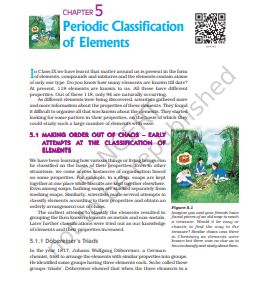‘NCERT Solutions for Class 10 Science Chapter 5‘ PDF Quick download link is given at the bottom of this article. You can see the PDF demo, size of the PDF, page numbers, and direct download Free PDF of ‘Ncert Class 10 Science Chapter 5 Exercise Solution’ using the download button.
NCERT Class 10 Science Textbook Chapter 5 With Answer PDF Free Download

Chapter 5: Periodic Classification of Elements
In Class IX we have learned that matter around us is present in the form of elements, compounds, and mixtures and the elements contain atoms of only one type.
Do you know how many elements are known to date? At present, 118 elements are known to us. All these have different properties.
Out of these 118, only 94 are naturally occurring. As different elements were being discovered, scientists gathered more and more information about the properties of these elements.
They found it difficult to organize all that was known about the elements. They started looking for some pattern in their properties, on the basis of which they could study such a large number of elements with ease.
5.1 Making Order Out Of Chaos
We have been learning how various things or living beings can be classified on the basis of their properties.
Even in other situations, we come across instances of organization based on some properties. For example, in a shop, soaps are kept together at one place while biscuits are kept together elsewhere.
Even among soaps, bathing soaps are stacked separately from washing soaps. Similarly, scientists made several attempts to classify elements according to their properties and obtain an
orderly arrangement out of chaos.
The earliest attempt to classify the elements resulted in grouping the then-known elements as metals and non-metals.
Later further classifications were tried out as our knowledge of elements and their properties increased.
5.1.1 Döbereiner’s Triads
In the year 1817, Johann Wolfgang Döbereiner, a German chemist, tried to arrange the elements with similar properties into groups.
He identified some groups having three elements each. So he called these groups ‘triads’. Döbereiner showed that when the three elements in a triad were written in the order of increasing atomic masses; the atomic mass of the middle element was roughly the average of the atomic masses of the other two elements.
5.1.2 Newlands’ Law of Octaves
The attempts of Döbereiner encouraged other chemists to correlate the properties of elements with their atomic masses. In 1866, John Newlands, an English scientist, arranged the then-known elements in the order of increasing atomic masses.
He started with the element having the lowest atomic mass (hydrogen) and ended with thorium which was the 56th element.
He found that every eighth element had properties similar to that of the first. He compared this to the octaves found in music.
Therefore, he called it the ‘Law of Octaves’. It is known as ‘Newlands’ Law of Octaves’. In Newlands’ Octaves, the properties of lithium and sodium were found to be the same.
Sodium is the eighth element after lithium. Similarly, beryllium and magnesium resemble each other. A part of the original form of Newlands’ Octaves is given in Table 5.3.
| Author | NCERT |
| Language | English |
| No. of Pages | 14 |
| PDF Size | 2.7 MB |
| Category | Science |
| Source/Credits | ncert.nic.in |
NCERT Solutions Class 10 Science Chapter 5 Chemical Reactions And Equations
1. Did Döbereiner’s triads also exist in the columns of Newlands’ Octaves? Compare and find out.
Solution:
Döbereiner’s triads did exist in the columns of Newlands’ Octaves; For example, the elements
Lithium (Li), Potassium (K), and Sodium (Na) constitute a Dobereiner’s Triad but are also found in the second column of Newland’s Octaves.
2. What were the limitations of Döbereiner’s classification?
Solution:
(i) They were not applicable for very low mass or very high mass elements.
(ii) All the elements couldn’t fit into Dobereiner’s triads.
(iii) As the methods to calculate atomic mass improved, Dobereiner’s triads validity began to decrease. For example, in the triad of F, Cl, and Br, the arithmetic mean of atomic masses of F and Br are not equal to the atomic mass of CI.
3. What were the limitations of Newlands’ Law of Octaves?
Solution:
Limitations of Newlands’ Law of Octaves are as follows
- Newlands’ Law of Octaves is applicable to elements up to Calcium
- Newland assumed there are 56 elements in nature and no more elements would be discovered in the future.
- To fit elements into the table Newland put two elements into one slot. Newland introduced unlike elements with different properties into one column.
- Iron (Fe) was placed away from elements that resemble properties. Ex: Nickel and cobalt
Periodic Classification of Elements NCERT Textbook With Solutions PDF Free Download
